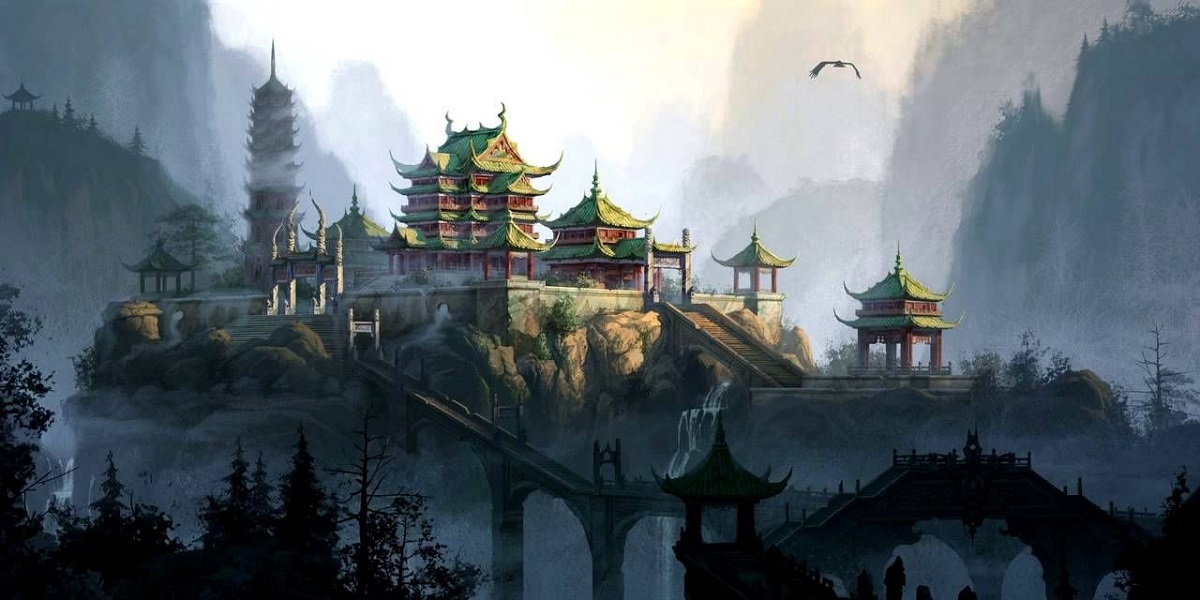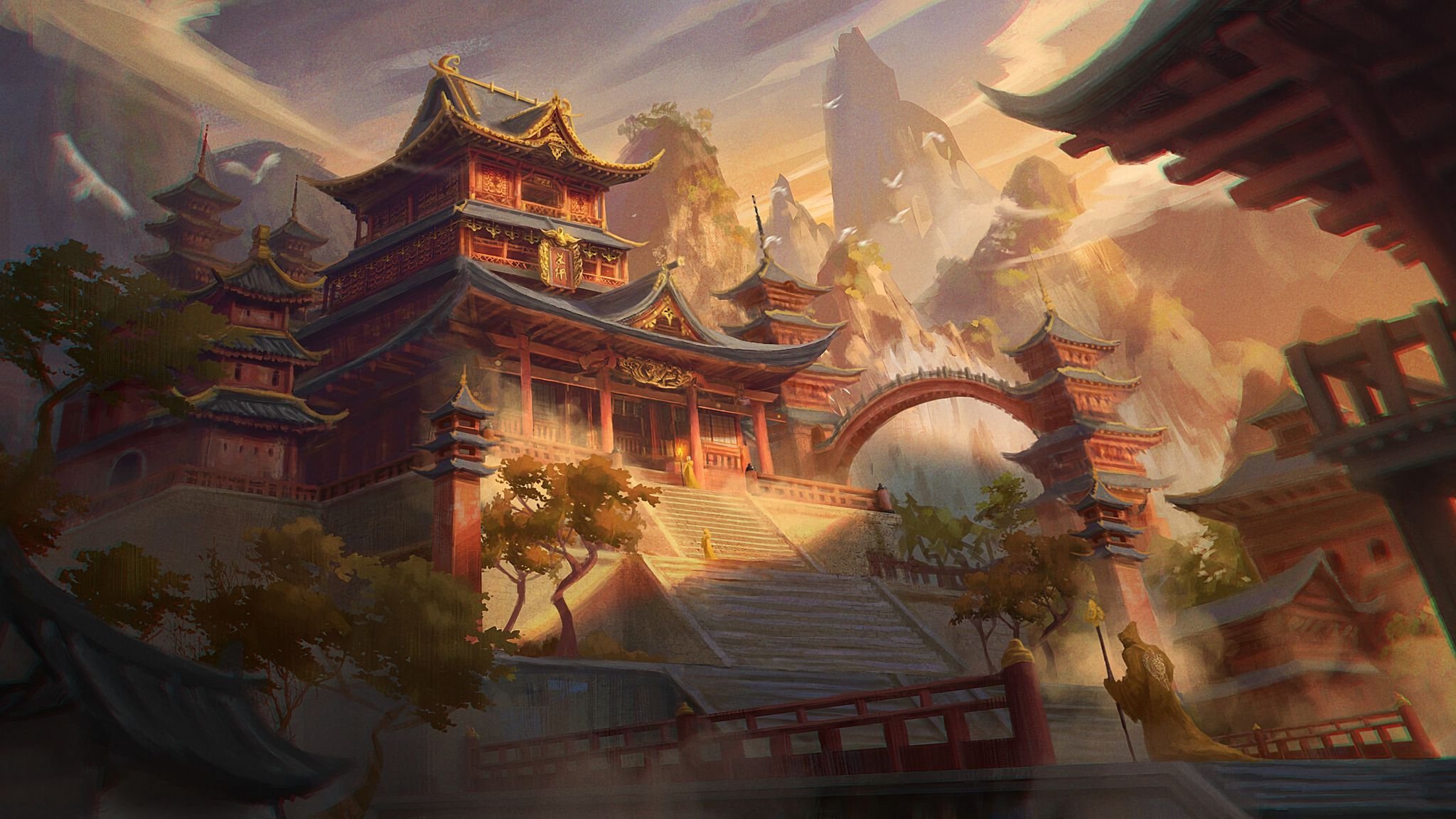The Empire of Honshu
The Empire of Honshu is vast, sprawling and split into seven provinces. It is a beautiful empire of rice fields, mountains and steaming jungles. It is very colourful and seems very peaceful, yet under this calm exterior, it can be a deadly place. Honshu is a place where honour and status mean everything. The smallest slight on a person above your rank can mean death.
Geography
Honshu is a vast place. On the main continent, only the Empire of Rodinia covers more area. Much of Honshu is coastal and these shores vary from being rough and rugged to low and sandy.
The far north of the land is bordered by high, granite mountains. These are cold and usually impassable in winter. The plains of the Kirin horse-lords abut these high hills.
The east is bordered mostly by coastline with the Sphinx and Ogre provinces both facing that way. The northern part of that coast is lower and more sandy. The southern end in the Ogre territory is more rugged as it feeds into the mountains.
The southern border of Honshu is almost entirely mountainous and a permanent battle zone. Beyond the high and craggy peaks lie the lands of the Rodinians. All the passes between the two empires are heavily contested and disputed.
The western most border of the empire is most varied. It includes the Great Desert in the south west and a few forests and swamps. The main neighbour to the west is Albion and, though small in size it has proven very resistant to Honshu’s efforts to annex it.
Provinces
There are seven geographical provinces in Honshu:- Naga Province
This province is home to many of the empire's best poets and artists. - Gryphon Province
The bulk of the empire's army comes from here with more samurai here than in any other province. - Dragon Province
Home to the famous Niten Dojo where samurai come from across the empire to be trained in this unusual and deadly style. Home of the emperors for the last century. - Phantom Province
The mysterious Ghostwalkers began life here, but are now in use across the whole empire. - Sphinx Province
The most powerful spellcasters and wu-jen can be found here. - Kirin Province
The most unusual province, home to wild horse lords who many in the empire consider to be barbarians. - Ogre Province The samurai of this province provides most of the leaders who defend the southeast of the empire from the barbarians of Rodinia. Home clan of the current emperor.
History
The Empire of Honshu was formally founded over five hundred years ago when the first Exulted One, the Light of Heaven, Katsura Masayoshi, brought the warring lands under his control with a mixture of astute politics, trickery, bribes and a great show of martial strength.
He managed to get each of the seven great warlords in the region to swear unending fealty to him and his line. In return, he put each of them in charge of their own Province and allowed them each to pick a mystical creature for the name of their Province. He named each of them his daimyo.
The line of Emperor of Honshu has continued ever since, but as Katsura neglected to formally include any specific definition of what "his line" really meant, the effect is that the position of Emperor has been a tenuous one at best.
Nowhere is this more pronounced than in recent years. In the year 655 AR, Emperor Toki Saza summoned his daimyo to Ido, knowing he was dying. He forced them to swear their loyalty to his young son, Katsu. They all swore to protect the dynasty and the young man until his majority. Saza died two months later and his young son took the throne. He lasted less than 2 years before he died under mysterious circumstances at the age of seven. His Shogun, the powerful Ogre clan warlord filled the void and took the title of Emperor.
In an unprecedented grab for power Emperor Enoeda chose not to relinquish his position as Shogun but rather he kept both titles to himself.
Since taking complete control of the empire the new Emperor has raised taxes, formed larger armies and reintroduced much of the state of subjugation that the Toki Saza had reduced. Under his leadership, the Empire of Honshu is now a far more dangerous place to live, but it is clear that the new Warlord also has eyes to expansion, both west into The Kingdom of Albion and south into The Empire of Rodinia.
Culture
The Empire of Honshu has become one of the most refined cultures in the Known World. Honour is everything in this land. Position is all. Each and every person needs to be aware of their place in the order of things and how to respond to those around them. There is a strong veneer of politeness in the realm and manners are hugely important to the way things are conducted day-to-day. Even the greatest lord will be polite to the lowest servant, in the ways that are accepted. The difference is, if the servant shows the lord even a hint of disrespect, the consequences would be severe, probably fatal. The basic culture here is one of a Feudal society where everyone swears loyalty to the person above them in the chain. At the top of the chain is the Emperor. The seven daimyo of the Provinces each bends the knee to him. In turn, each provincial lord has many vassals loyal to him. These vassals typically control the towns or villages of their region, though some live in huge fortified castles, separate from any settlements.Languages
Most people in the Empire speak the unified language of the country, known as Honshu. Additionally, each province has its own dialect. It's usually possible to tell which Province a person is from, based on their accent when speaking Honshu. The sidebar lists languages a character from Honshu might choose from.Caste
There is an immutable caste system in place in Honshu. This has been in place for five hundred years and is a permanent part of the culture of the Empire. The samurai are set above all. Beneath the samurai are the peasants, next the craftsmen, then the merchants, followed by actors, outcasts and bandits. Finally at the bottom are the eta, the non-humans, those who deal with dead bodies, the curing of leather and the handling of dead animals. Of course, the gaijin, the barbarian outsiders of other lands, are so insignificant as to not even rank in the caste system.Weapons
With the ascension of Emperor Enoeda to the throne, new laws have been passed. Now only the samurai caste can bear arms or wear armour in the lands of Honshu. For others to do so is considered treason and results in death. Not reporting someone for this crime is also considered treason. In both cases, death is not restricted to the person in question but also to their extended family. Enoeda has made it clear he will risk no revolt from the peasants. The samurai caste typically carries the daisho; the combination of the long, curved katana and the short wakizashi swords. These are the symbol of the samurai's supremacy. Many of these swords have long and storied histories as important as those of the men who wield them. The sidebar at the right lists the weapons and armour types that are considered legal for the non-samurai caste to carry. These are generally considered "heavy clothes" in the case of the armour, and "farming or hunting tools and implements" in the case of the weapons listed. Anything not on those lists is illegal for non-samurai to carry. Additionally, any weapons typically associated with Ghostwalkers (shuriken etc.) are illegal and considered extremely dishonourable.Rulership and Fealty
The Emperor is the ultimate ruler in the Empire of Honshu and the seven daimyo swear allegiance to him and obey his every command. Together these seven form the Council of Regents and advise the emperor. Within their provinces, the seven daimyo have total power. Each has a number of vassals who swear fealty to them and control the towns and villages of the province. Of course, all of these are of the ruling samurai caste. Each vassal in turn has a cohort of samurai to control and command their lands. Each town or village has a headsman who looks after the peasants of that settlement. They are responsible to make sure that the samurai who controls the settlement is kept happy. They must collect the taxes and ensure they are paid on time. Headsman is an honoured position and the highest place that a peasant can expect to rise to.Politics and Control
Historically the emperor would rule the empire from the capital city of Ido . His role was to lead the empire spiritually, being the embodiment of perfection as sought by all those in the empire. It was considered that the day-to-day running of the provinces was beneath his dignity and the seven daimyo, the Council of Regents would carry out this role in his name. In order to ensure the security of the empire the position of Warchief, known as the Shogun, exists. The emperor supposedly picked the Shogun, but in practice, he was selected by the Council of Regents and would always be the most powerful of the daimyo. Just over twenty years ago the child emperor, Katsu, died under mysterious circumstances. The Shogun, Enoeda, with the backing of the Council of Regents, took the title of Emperor for himself, naming his younger brother as daimyo of the Ogre Province but he never relinquished his position as Shogun. So, in an unprecedented period of time in the history of the empire, one man currently holds both the title of Emperor and Shogun at the same time. His power in the empire is thus total.
Alternative Name(s)
Honshu
Type
Region
Location under
Included Locations
Included Organizations
Owner/Ruler
Related Ethnicities
Related Tradition (Primary)




